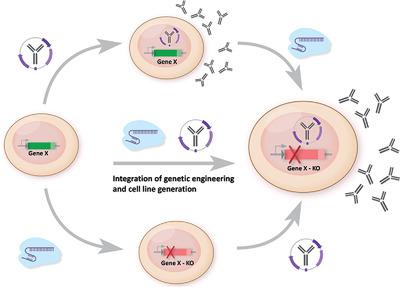当前位置:
X-MOL 学术
›
Biotechnol. J.
›
论文详情
Our official English website, www.x-mol.net, welcomes your
feedback! (Note: you will need to create a separate account there.)
CRISPR/Cas12a‐mediated CHO genome engineering can be effectively integrated at multiple stages of the cell line generation process for bioproduction
Biotechnology Journal ( IF 3.2 ) Pub Date : 2020-12-23 , DOI: 10.1002/biot.202000308 Patrick G. Schweickert 1 , Ning Wang 2 , Stephanie L. Sandefur 2 , Michael E. Lloyd 2 , Stephen F. Konieczny 1 , Christopher Frye 2 , Zhuo Cheng 2
Biotechnology Journal ( IF 3.2 ) Pub Date : 2020-12-23 , DOI: 10.1002/biot.202000308 Patrick G. Schweickert 1 , Ning Wang 2 , Stephanie L. Sandefur 2 , Michael E. Lloyd 2 , Stephen F. Konieczny 1 , Christopher Frye 2 , Zhuo Cheng 2
Affiliation

|
Most biopharmaceuticals produced today are generated using Chinese hamster ovary (CHO) cells, therefore significant attention is focused on methods to improve CHO cell productivity and product quality. The discovery of gene‐editing tools, such as CRISPR/Cas9, offers new opportunities to improve CHO cell bioproduction through cell line engineering. Recently an additional CRISPR‐associated protein, Cas12a (Cpf1), was shown to be effective for gene editing in eukaryotic cells, including CHO. In this study, we demonstrate the successful application of CRISPR/Cas12a for the generation of clonally derived CHO knockout (KO) cell lines with improved product quality attributes. While we found Cas12a efficiency to be highly dependent on the targeting RNA used, we were able to generate CHO KO cell lines using small screens of only 96–320 clonally derived cell lines. Additionally, we present a novel bulk culture analysis approach that can be used to quickly assess CRISPR RNA efficiency and determine ideal screen sizes for generating genetic KO cell lines. Most critically, we find that Cas12a can be directly integrated into the cell line generation process through cotransfection with no negative impact on titer or screen size. Overall, our results show CRISPR/Cas12a to be an efficient and effective CHO genome editing tool.
更新日期:2020-12-23









































 京公网安备 11010802027423号
京公网安备 11010802027423号